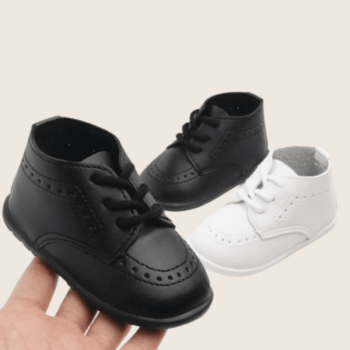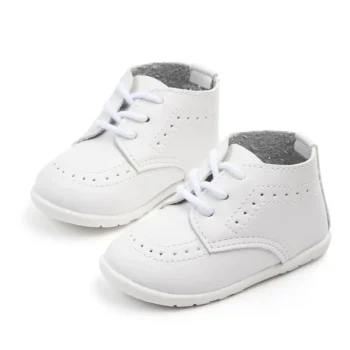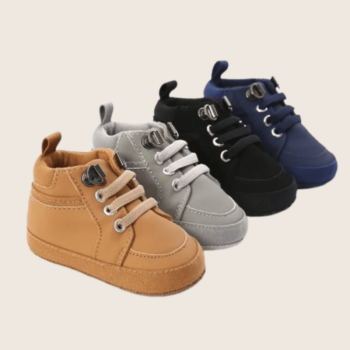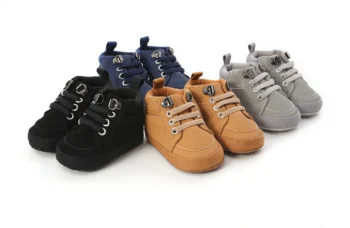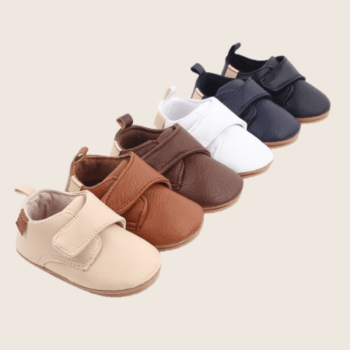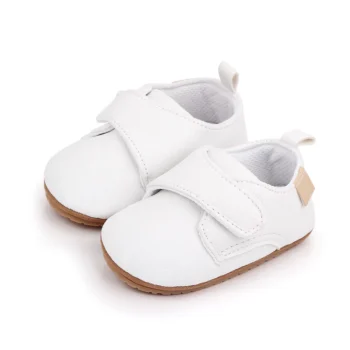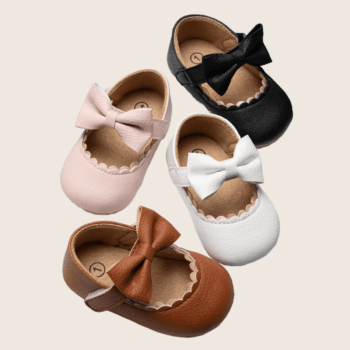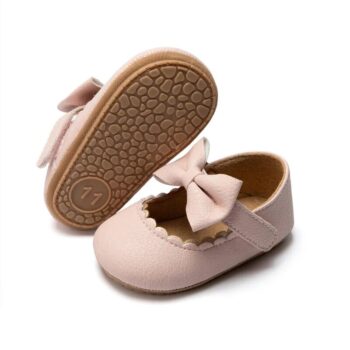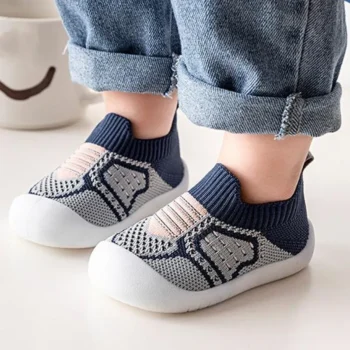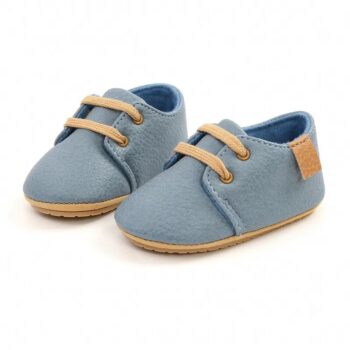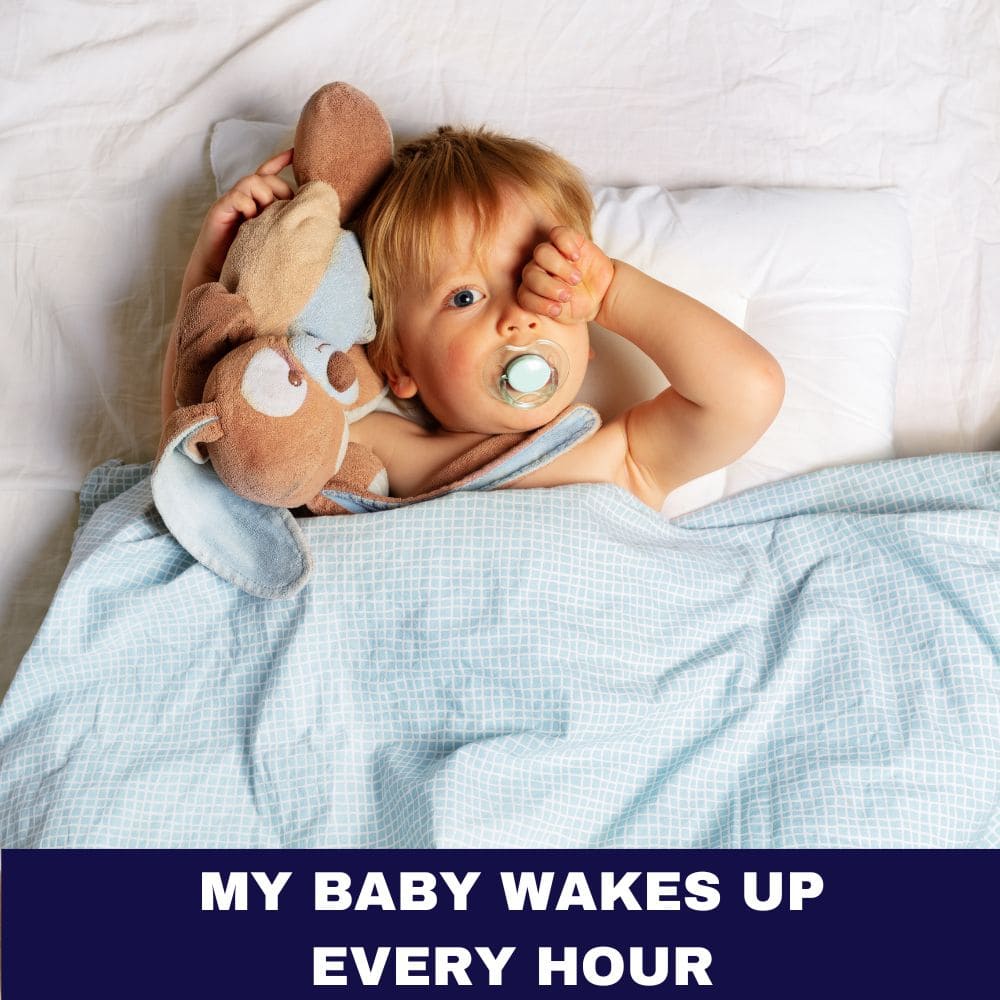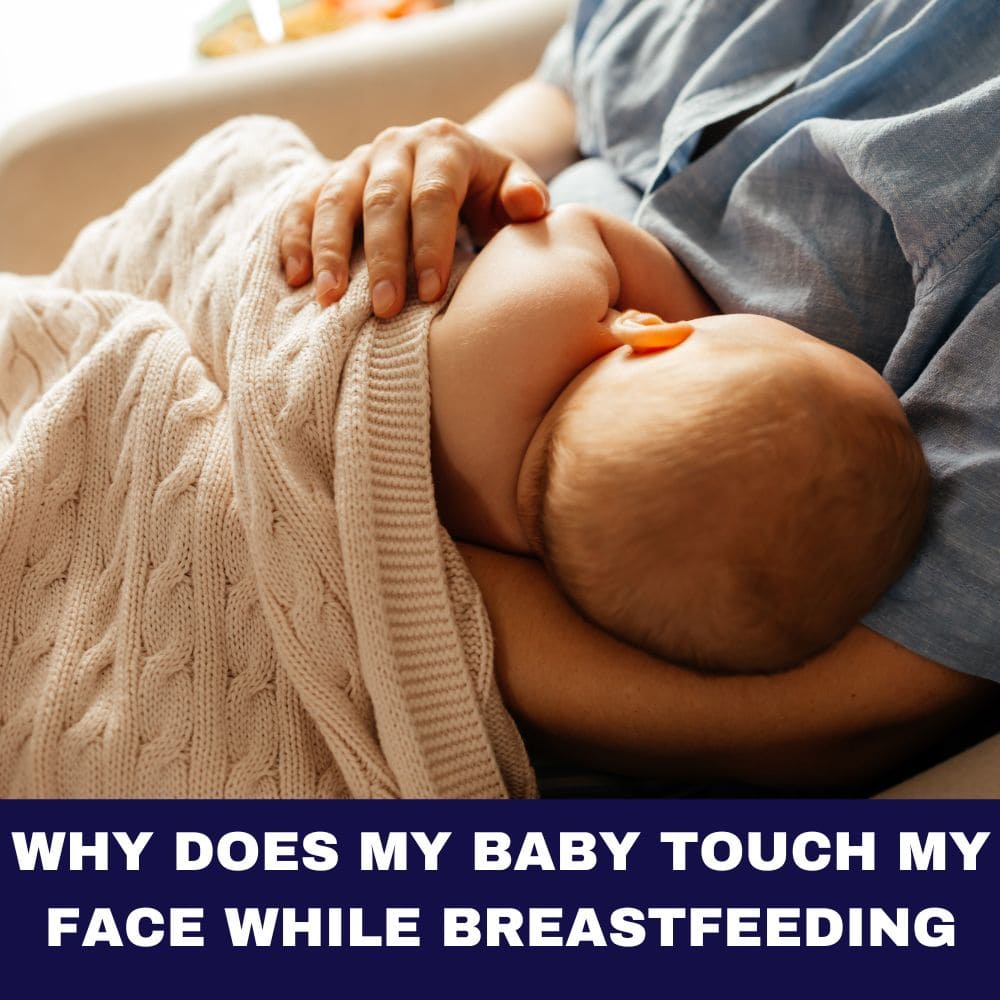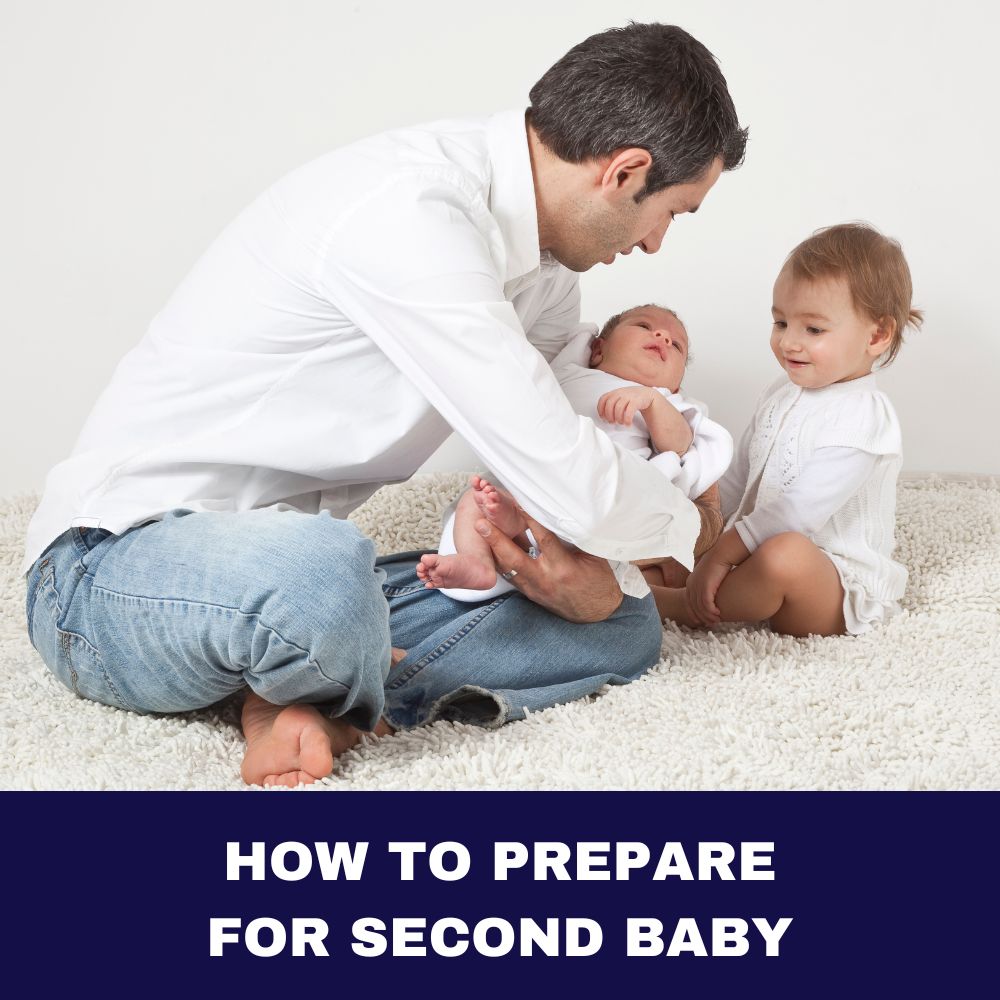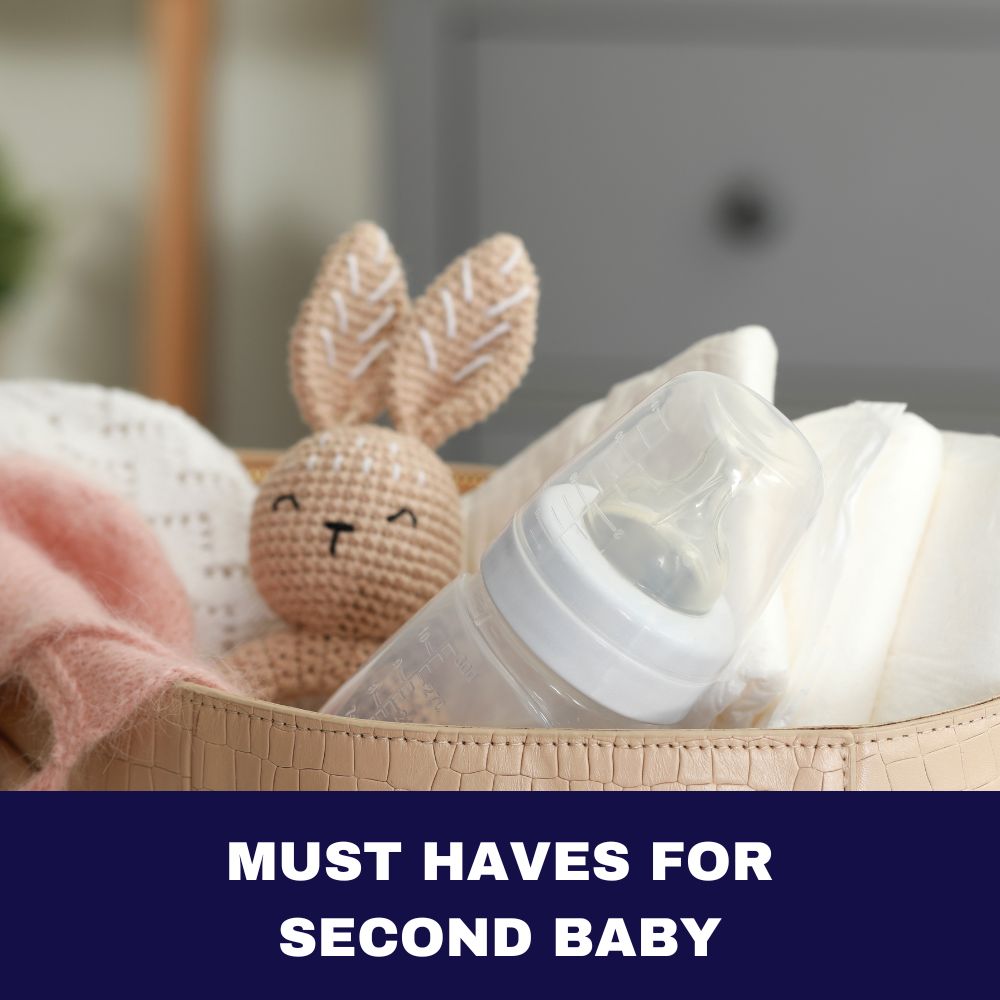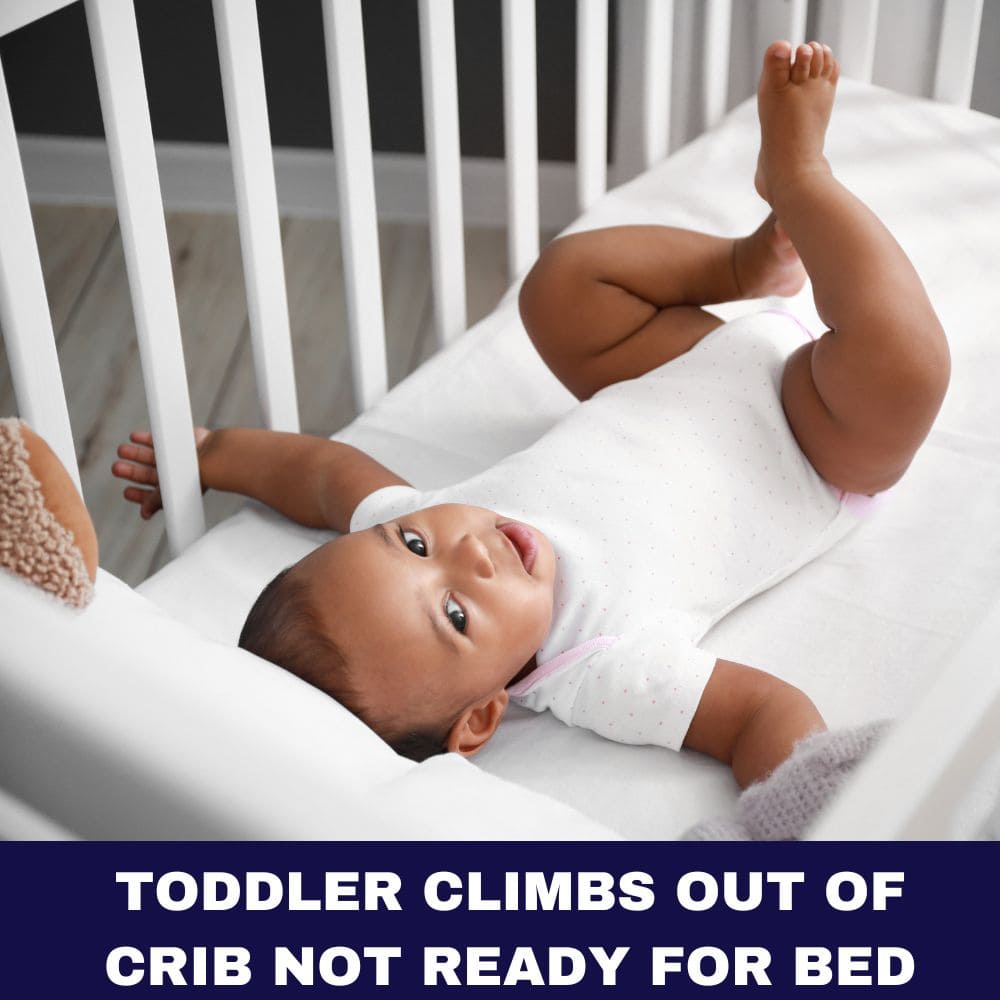As a parent, you likely want to ensure your little one has the best start in life. A common question many of us have is what age can babies wear shoes? In this comprehensive guide, I’ll walk you through when experts recommend introducing shoes, the benefits, what to look for, and tips for keeping those tiny toes healthy as they grow.
A Baby’s Foot Development Milestones
Before discussing what age can babies wear shoes, it’s helpful to understand how their feet progressively develop and get exercise those first couple years:
- 0-2 months: A newborn’s feet initially curl inward and lack muscle tone. But they’ll start moving their legs and feet more, and grasping reflexes in their toes emerge.
- 3-8 months: As babies start sitting up, crawling, and cruising along furniture, their feet gain strength and stability from these movements. The feet learn to grip and bear more weight.
- 9-16 months: Pulling up to stand, cruising along furniture walking while supported, and finally taking those first exciting solo steps – all these milestones involve the feet and leg muscles gaining more control and coordination.
- 18 months: Most babies are walking independently around this age. Their feet and leg muscles get quite a workout from all the practice!
- 2-3 years: Increased coordination as they start walking confidently, running, jumping, going up and down stairs. Their feet grow rapidly during these busy toddler years.
Knowing these foot development milestones helps provide context on what age can babies wear shoes appropriately.
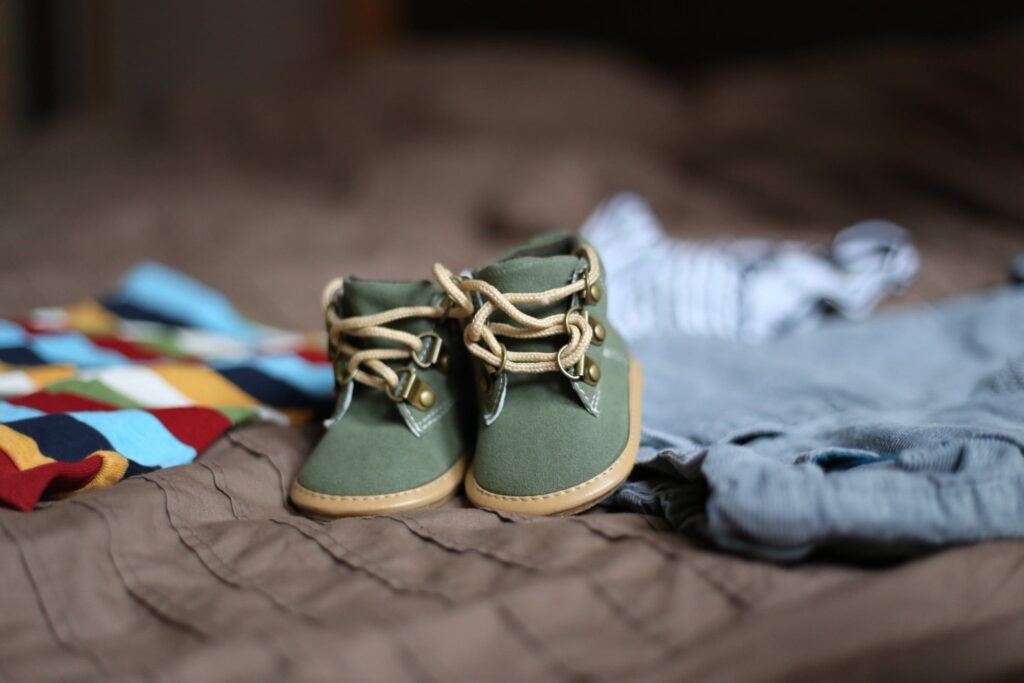
Do Babies Really Need Shoes in the First Year?
The short answer is – not really!
In the first 12 months, your baby’s feet grow very quickly, almost 3 sizes in the first year alone. Confining growing feet in shoes too early can actually limit their natural development.
Going barefoot allows your baby to grasp with their toes, flex their feet, and feel different textures under their feet. This sensory input is important for strengthening their arches, ankles, leg muscles, balance and coordination.
Think about when your baby is learning to walk – their feet bend, curl, and grip the floor. Hard, overly supportive shoes constrict this movement, negatively impacting their natural walking development.
So keeping those tiny feet bare as much as possible is best in the early months. Shoes aren’t strictly necessary for newborns and infants when considering what age can babies wear shoes. Their feet are learning and getting exercise through their daily movements.
Potential Benefits of Wearing Shoes for Older Babies
While not required, there are some potential benefits to starting shoes once your baby is a bit older and more mobile:
- Protection – Once crawling, cruising and taking steps, shoes can protect their feet from scrapes, bruises or injuries from debris on the floor.
- Warmth – Shoes provide warmth and coverage for feet when outdoors in cold weather. Just be sure to monitor that their feet don’t get too hot and sweaty, either.
- Balance & Traction – Properly fitted grippy shoes can help steady new walkers and enhance their coordination on various surfaces.
So in summary, shoes can be helpful for some older babies in certain situations, provided you choose appropriate supportive styles for this stage (more details on this below!).
What Age Can Babies Wear Shoes? – General Recommendations
There is no set age when shoes universally become an absolute necessity for all babies. Every child develops on their own timeline. But here are some general guidelines pediatricians recommend on what age can babies wear shoes:
- 12-18 months – Once regularly walking well, lightweight and flexible shoes can be introduced for short periods indoors or gentle outdoor surfaces. But shoes shouldn’t be worn all day at this age.
- Avoid shoes before walking – Let those tiny feet grow and move barefoot as long as possible. Only use shoes if walking very early (under 12 months) and for protection outdoors on rougher surfaces.
- Professionally fitted at 18-24 months – Around 6 months after your child starts walking well on their own, take them for their first professional shoe fitting. This ensures proper support and fit as their feet rapidly grow.
The most important takeaway is to allow your baby to go barefoot at home as much as possible during those first couple years. Don’t rush into shoes before their feet have naturally developed strength and mobility.
Should Babies Wear Shoes When Learning to Walk?
I recommend letting your baby learn to walk barefoot as much as possible initially. It allows them to grip with their toes, improving balance, strength and stability.
Lightweight, flexible shoes can provide a bit of protection once they’re cruising and taking first steps. But avoid making babies rely on bulky, overly supportive shoes as “walking aids” early on – barefoot practice is ideal.
If you do use shoes for a new walker, look for:
- Super flexible, thin soles that easily bend and move with their feet
- Breathable, soft uppers that won’t rub
- Grips on the bottom for traction
- Snug but not too tight fit around the foot and ankle
Well-fitted shoes should not interfere with or hinder your baby’s natural walking development. Prioritize barefoot practice while first learning this major motor skill when considering what age can babies wear shoes.
-
HarmonyHub Sleep Companion – White Noise Machine – Soothing Sound & Light Machine Original price was: $65.00.$41.95Current price is: $41.95.
Discover tranquility with HarmonyHub Sleep Companion—a portable sleep sound machine designed for restful nights and relaxation.
Featuring 34 soothing sounds, 7 customizable night light colors, and precise volume and timer controls, this sleek white device is perfect for creating a serene sleep environment.
With a built-in rechargeable battery, it’s your go-to solution for a peaceful night’s sleep at home or on the go.
-
Genuine Leather Lace-Ups – Baby Shoes Original price was: $21.00.$15.95Current price is: $15.95.
Genuine Leather Lace-Ups: Elevate your little one’s style with these soft leather shoes featuring a secure fit, flexible sole, and stylish design.
- Mesh upper material – breathable knitted fabric
- Rubber outsole – provides non-slip traction
- Cotton lining – soft interior comfort
- Elastic ankle opening – for easy slip-on fit
- Textile insole – cushions baby’s steps
- EVA midsole – shock absorption and support
- Plastic heel counter – stabilizes the heel
- Printed exterior fabric – fun mixed patterns
- Metal eyelets – for laced closure security
- Synthetic trim – decorates shoe exterior
-
Cozy Crib Kicks – Baby Shoes Original price was: $25.00.$17.95Current price is: $17.95.
Cozy Crib Kicks: Embrace your little one’s milestones in style with these soft, lightweight shoes featuring a secure fit and non-slip sole.
- Upper: Soft, lightweight PU leather
- Sole: Non-slip cotton sole
- Lining: Breathable fabric
Out of stock
-
Little Leather Laces Baby Shoes $15.95
- Upper: Soft, supple leather
- Sole: Non-slip rubber
- Embellishment: Butterfly bow
Choosing the Best First Shoes for Baby
Here are key features to look for when selecting those first shoes once your baby is ready:
- Flexible soles – Allows feet to grip, bend, and move naturally. Avoid very stiff, inflexible soles.
- Breathable uppers – Prevents sweaty feet. Look for airy, lightweight materials like soft leather or breathable cotton.
- Non-slip grips – Gripping soles help prevent slips and falls for wobbly new walkers.
- Proper snug fit – Room to wiggle toes freely, but heels should not slip up and down. Adjustable closures like velcro or elastic laces help get the perfect custom fit.
- Low heel – Babies learn to walk better in flats with minimal heel lift. Avoid grown-up shoes with tall heels.
Steer clear of shoes that are overly rigid, or made with heavy plastic, thick rubber, or vinyl materials. Proper development depends on appropriate shoe selection based on what age can babies wear shoes.
Get your child professionally fitted every 2-3 months once they start wearing shoes, since their feet literally grow like weeds! Well-fitted, supportive shoes ensure healthy foot growth.
Eco-Friendly Baby Shoe Options
As an eco-conscious parent, I know you probably think about the environment your child is growing up in. Seek out sustainable shoes when possible:
- Natural materials – Shoes made with leather, cotton, wool and other breathable materials are gentler on skin and break down easier than synthetic materials.
- Recycled materials – Look for shoes constructed with recycled plastic bottles, recycled foam, recycled rubber, etc. This helps reduce waste.
- Organic/non-toxic materials – Shoes made with organic cotton, non-toxic dyes, sustainably sourced rubber, etc. are better for babies’ sensitive skin and the earth.
- Adjustable sizes – Shoes with buckles, velcro straps, or elastic laces allow the size to adjust as baby’s feet grow. These adjustable grow-with-me styles last longer!
- Hand-me-downs – Pass along gently used shoes that still have life left to other parents in your community. This reduces demand for manufacturing new shoes.
With some savvy research, you can find eco-friendly shoes to help your mini fashionista make a smaller footprint from those tiny first steps!
-
Twinkle Toes – Baby’s First Walking Shoes Original price was: $20.00.$14.95Current price is: $14.95.
“Twinkle Toes” Baby Casual Shoes offer creative and adorable style with bowknots, perfect for various activities. Crafted with non-slip rubber and soft PU, they ensure comfort and support for your baby’s first steps.
- Non-slip Rubber
- Soft-Sole
- Flat PU (Polyurethane)
- Elastic upper material
- High-quality rubber material
-
Li’l Walkers Sock-Shoes $15.55
[cg_accordion title=”Detail”]
These adorable slip-on sock shoes are perfect for baby’s first steps! The soft knit fabric and non-slip rubber soles provide comfort and stability for new walkers. With cute patterns and a true-to-size fit, these shoes support natural foot development in any season.
[/cg_accordion]
[cg_accordion title=”Material”]
- Knitted fabric upper
- Rubber outsoles
- Cotton lining
- Elastic opening
- Textile insoles
- PU detailing
[/cg_accordion]
[cg_accordion title=”Delivery & Return”]
Enjoy free shipping on all orders, with a hassle-free 30-day return policy. Our products typically ship within 2-3 working days, and delivery usually takes 5-10 working days.
[/cg_accordion]
[cg_accordion title=”Care Guide”]
- Machine wash cold, gentle cycle
- Air dry only, do not machine dry
- Do not bleach or iron
- Spot clean stains as needed
- Check for wear on soles before each use
- Hand wash for delicate items
- Store in cool, dry place away from direct sunlight
- Stuff with paper to retain shape when not in use
- Avoid exposing to excess moisture or heat
- Check sizing periodically as baby’s feet grow
[/cg_accordion]
-
BreathWeave Walkers – Baby’s Mesh First Shoes Original price was: $25.00.$17.95Current price is: $17.95.
BreathWeave Walkers feature a breathable mesh upper and non-slip rubber sole designed to support babies during their all-important first steps.
- Mesh upper material – breathable knitted fabric
- Rubber outsole – provides non-slip traction
- Cotton lining – soft interior comfort
- Elastic ankle opening – for easy slip-on fit
- Textile insole – cushions baby’s steps
- EVA midsole – shock absorption and support
- Plastic heel counter – stabilizes the heel
- Printed exterior fabric – fun mixed patterns
- Metal eyelets – for laced closure security
- Synthetic trim – decorates shoe exterior
-
LeatherSteppers – MYGPP Baby Shoes Original price was: $20.00.$16.95Current price is: $16.95.
The LeatherSteppers shoes feature premium leather uppers and anti-slip rubber soles designed to support babies during their important first steps. The soft leather provides comfort while the durable sole gives traction for those early walkers. With vibrant colors and prints, these shoes keep your child safe while making walks fun.
- Leather upper – soft and comfortable
- Rubber outsole – provides traction and anti-slip grip
- Cotton lining – breathability and moisture absorption
- Lace-up closure – adjustable fit
- Textile insole – cushions baby’s steps
- EVA midsole – shock absorption and support
- TPR heel counter – stabilizes the heel
- Synthetic trim – decorative accents
- Multicolor prints – fun patterns and designs
- Metal eyelets – for secure lace closure
The Importance of Barefoot Time
I really can’t emphasize enough the importance of regular barefoot time for proper foot development.
- Let those toes be free! Allow your baby to kick off their shoes once indoors.
- Bare feet help strengthen foot and leg muscles and enhance balance and coordination naturally. No shoes required!
- Cool floors provide stimulating sensory feedback that curious baby brains crave.
Giving your child the freedom to flex and scrunch their toes without confining shoes promotes healthy musculoskeletal development. Plus, many babies find bare feet more comfortable for playtime once they start walking.
So go shoeless as much as possible while considering what age can babies wear shoes recommendations. Their feet will thank you!
Caring for Growing Baby Feet
Once your baby starts using their feet for mobility, be diligent about foot hygiene and care:
- Wash feet daily – clean, dry feet prevent irritations, fungus, and bacteria from sweaty shoes. Gently dry carefully between the toes.
- Massage feet – promotes healthy circulation, joint flexibility, and bonding!
- Apply lotions or powders – keeps skin soft and supple, prevents cracking and peeling skin.
- Check for redness between toes – this can signify friction that may lead to blisters.
- Allow ample barefoot time – strengthens feet naturally and prevents shoe-induced problems.
- Get professionally fitted shoes – ensures proper support and fit as their feet rapidly grow.
Establishing solid foot care routines now prevents problems down the road as your child walks, runs and plays.
Prioritizing Development Over Fashion
When shoes shopping for your trendy mini-me, remember:
Proper foot development is far more important during the early walking years than cute styles or colors. Be patient, and let those adorable bare feet and toes do their important job!
There will be plenty of time for fashionable shoes later. For now while considering what age can babies wear shoes, focus on flexibility, breathability and comfort over accessorizing.
By letting your child’s feet build natural strength barefoot now, you set them up for a lifetime of healthy, happy feet!
Let me know if you would like me to expand or modify the post further. I aimed to provide an in-depth guide for parents considering what age can babies start wearing shoes.



